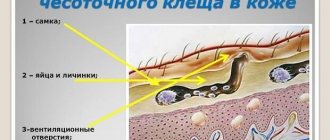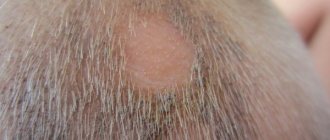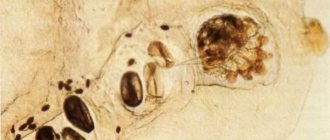Our body contains many harmful and dangerous parasitic microorganisms. Under normal conditions and with a good immune system, they are not harmful. One of these parasites is the acne gland, which, under favorable conditions, becomes the cause of the disease - demodicosis. According to statistics provided by medical institutions, this disease accounts for 7-10% of all calls for skin problems.
Is demodicosis contagious or not, is it transmitted from animals and people?
The human body is constantly exposed to external factors.
In particular, ticks can not only cause trouble with their bites, but are also carriers of many infectious diseases. One of these pests is demodex. In size, it reaches only 0.3-0.4 mm and therefore it is visually impossible to find out about its presence in the body, only by characteristic symptoms.
Having learned that someone has been found to have such a tick, many people have questions: is demodicosis contagious in humans and how can it be transmitted? To understand how demodicosis is transmitted, you need to know what the cause of this skin disease is, how it manifests itself and how demodicosis can be transmitted between people and animals.
What is demodicosis
Demodicosis is a dermatological (skin) disease that develops as a reaction of the body to the presence of demodex mites in the body. It has been scientifically proven that demodex mites are present in the body of 90% of the planet's inhabitants, but not everyone experiences the disease. This disease can be called seasonal, as it worsens during the autumn suppression of immunity.
Also, with age, the tendency to this disease increases. Children are less susceptible to developing demodicosis - this is associated with less sebum production. The mite, as a rule, settles in the sebaceous ducts of the skin or hair follicles, and when the body is weakened, it is activated, which manifests itself as a skin rash similar to acne.
Most often, the parasite affects the skin on the face - forehead, nasolabial triangle, eyelids, chin, and outer ear area. The rash also sometimes spreads to the head, back and chest. The rash is formed as a result of the body’s reaction to the waste products of the tick.
The first symptoms by which a skin disease can be recognized are inflammation of the skin, including acne. The disease is also accompanied by:
- itching;
- tingling;
- the affected areas of the skin peel off;
- pores are enlarged.
If the pest has settled in the eyelids, a purulent compartment forms in the corners of the eyes, eyelashes become thinner and may even fall out. At the same time, the eyelids become heavier, redness appears, and scales may appear near the base of the eyelashes.
When the activity of the mite intensifies near the tear duct of the eye, dry eye syndrome may develop. Seborrhea forms on the scalp with demodicosis. It manifests itself as increased sebum secretion (hair quickly becomes oily) and hair loss.
Also, the presence of a mite is determined by examining the eyelash and eyebrow hair - the pest can hide in the eyelash follicle, but due to its small size, it can only be seen with a microscope.
Since the tick lives at rest in the deep layers of the skin, the disease can be provoked by deep cleansing of the skin (peeling), visiting a sauna or steam bath (when steaming, the pores of the skin open and the tick comes out into the upper layers).
Methods of infection
The skin mite activates its activity when the body is weakened. The following factors can weaken the body’s protective function:
- alcohol abuse;
- smoking;
- stress;
- hereditary predisposition;
- decreased immunity; allergic reactions;
- insomnia;
- disruption of the endocrine system;
- use of certain medications;
- diabetes mellitus;
- chronic fatigue.
But you shouldn’t completely isolate the patient; it’s enough to make it a rule to wash your hands and iron your bed linen more often. You can provide the patient with an individual set of towels and limit physical contact.
How is the subcutaneous tick transmitted?
Demodectic mange can spread from a sick person to a healthy person through touch. The parasite can also be transmitted through common hygiene products, feather pillows, and bedding. Typically, these household items are shared among family members, so if one family member is sick, then others are at risk. People with reduced immunity are especially susceptible to infection.
Demodicosis is transmitted both from a sick person and from a tick carrier. The person himself may not even know that he is a carrier, but transmission to a weakened body is quite possible.
Is demodicosis contagious?
Many who have encountered a subcutaneous mite that has manifested itself in a person or a pet often ask at a doctor’s appointment: “Is demodicosis contagious or not? Can a tick pass from person to person? Is the subcutaneous mite in cats transmitted to humans or not? Is demodicosis in dogs contagious to humans or does it pose no danger? And in general, is this disease transmitted from any animals to people and vice versa?” Let's look into these issues. Sometimes pets can suffer from demodicosis. Demodicosis in cats and dogs living at home is much less common than in their homeless relatives. This skin disease is very contagious, but only to other animals, that is, it is not transmitted from a cat or dog to humans. This is due to the fact that the disease in humans and animals is caused by different types of demodex mites - the mite Demodex folliculorum and Demodex brevis parasitizes humans, and Demodex canis parasitizes pets. Just as human demodicosis is not contagious to four-legged friends, animal ticks are not transmitted to people. But you should still limit contact with a sick animal until it has fully recovered. A domestic contagious cat or dog must be treated for this disease. Firstly, pets do not look attractive, since Demodex canis causes hair loss in entire areas and pets look bald. Secondly, the tick can provoke the development of various complications (areas with lost skin can go into the stage of ulcers), which will later be more difficult to cure, and the diseases that the pet may develop can complicate the life of the owner himself.
To summarize, we can easily say that Demodex is contagious, but since it comes in different types, the disease is not transmitted from people to animals and vice versa.
Source: //makushkainfo.ru/zabolevaniya/demodekoz/zaraznoe-zabolevanie-ili-net.html
Are subcutaneous ticks contagious in humans?
It is generally accepted that demodicosis is transmitted through contact with an infected person, when there is direct contact with diseased hair, eyebrows and sebaceous glands. Scientists have found that subcutaneous mites do not adapt to life outside the host, but some studies indicate that the parasite remains alive in the external environment for quite a long time.
In water, a tick can survive at 15 degrees for up to 25 days. On dead skin it remains viable for about 20 days. However, the question of whether parasites that survive such situations can infect people still remains unanswered.
Demodex is an opportunistic microorganism. 90% of the world's population has mites on their skin. However, not everyone shows signs of the disease. Most people are carriers.
The subcutaneous mite is localized on the face and head, since this is where a large number of hair follicles and sebaceous ducts are concentrated. The parasite feeds on particles of the epidermis and lard. During the entire period of active reproduction of microorganisms, a person does not feel anything.
Experts call the first manifestations the presence of rosacea - acne. There are inflammations, pustules, redness of the skin, spider veins, and enlarged pores. I am concerned about itching and a feeling of tightness of the skin on the face.
According to experts, demodicosis is transmitted to babies from the mother on the seventh day after birth. Symptoms do not always appear. That the disease is transmitted from person to person has been proven repeatedly. There are several ways of infection, but close contact with the source of the disease is always necessary.
Demodicosis
Demodicosis in humans is transmitted through hugs, kisses, contact with infectious things, bedding, hygiene products, through hats, combs, towels, napkins. Demodectic mange is contagious in humans even in the absence of clear symptoms of the disease, even if they are carriers.
One of the most pressing and completely unresolved issues is the question of how ticks are transmitted. Scientists have not fully figured out whether the presence of this parasite on human skin and sebaceous glands is a pathology or not.
The subcutaneous mite feeds on skin cells, sebum and hormones. The presence of three mites in a human hair follicle does not manifest itself clinically. In case of health problems, this parasite begins to actively reproduce and after 20 days it dies and begins to decompose.
In this case, damage occurs to the skin of the face, scalp, forehead, eyelids and nasolabial folds. If treatment is not started on time, a person may develop a number of complications such as blepharoconjunctivitis, extensive purulent rashes, and allergic reactions. People with oily skin, especially women over forty, are most susceptible to infection with demodicosis.
Demodicosis - does such a disease exist?
Scientists' opinions about Demodex mites as a cause of skin pathologies are varied and contradictory. Two species, D. follikulorum and D. breis, are part of a community of opportunistic parasites on human skin.
Demodex feeds on sebum and usually does not harm human skin.
The presence of mites on the skin, eyebrows and eyelashes does not necessarily lead to the development of demodicosis. It is this fact that explains the doubts about whether it is a disease or not. The medical literature provides data that pathology ranks seventh in prevalence among dermatoses.
Signs of demodicosis infection:
- formation of papules, red spots, papulopustules on the face and chest;
- peeling along the edge of the eyelashes and in the eyebrow area;
- itching and other unpleasant sensations;
- the appearance of compactions in the skin;
- hyperkeratosis;
- pain in the eyes.
Researchers have found colonies of the parasite in patients with diseases such as acne, rosacea, pustular folliculitis, and perioral dermatitis. When researchers prove the active participation of demodex in the development of acne, doctors will be able to more often prescribe ointments with acaricidal substances, such as permethrin, to patients.
Why is Demodex contagious for some people and not for others?
The most common theory explains the parasitic nature of the tick. When the microflora is undisturbed, demodex does not manifest itself in any way. Symptoms of the disease appear in three cases: if people have hypersensitivity to the toxins of the parasite, with skin dysbiosis and excessive activity of the sebaceous glands.
The infectivity of demodex plays a secondary role. The fact is that the pathogenicity of a tick for a particular person does not depend on the characteristics of the parasite, but on the immunity and hormonal levels of the host itself.
To exist outside human skin, mites require a temperature of about 37°C and other favorable conditions that they rarely find in the environment.
Typically, a highly infectious infectious agent or parasite remains viable for a long time outside the host body. Transmission occurs through the air, household objects and direct contact of sick people with healthy people.
Thanks to Demodex, pyogenic cocci, as well as causative agents of seborrheic dermatitis and papular folliculitis, penetrate into the deep layers of the skin. Skin affected by one infectious disease becomes more susceptible to others.
Predisposing factors
The subcutaneous mite on the face is contagious, but the likelihood of infection in the infected person is extremely low. Weakened or pathologically weak immunity contributes to the development of demodicosis. The body is unable to restrain the vital activity of microorganisms, and symptoms appear.
Contribute to the development of demodicosis:
- chronic fatigue;
- stressful situation;
- exhaustion of the nervous system;
- heredity;
- oily skin type, improper functioning of the sebaceous glands;
- hormonal disbalance;
- metabolic disease;
- poor facial hygiene;
- squeezing pimples;
- alcoholic drinks;
- smoking;
- abuse of fried, spicy foods;
- prolonged exposure to direct sunlight;
- pregnancy;
- liver pathologies;
- long-term use of antibiotics and other medications;
- frequent colds with high fever;
- taking hormonal medications;
- pathologies of the endocrine system, abnormal functioning of the thyroid gland;
- tendency to allergies;
- intestinal diseases;
- fungal infection;
- chronic pathologies.
Causes
The risk of developing demodicosis increases with simultaneous exposure to unfavorable factors.
The tick is transmitted from person to person, but while on the surface of the skin, it may not manifest itself in any way. But there are a number of conditions that cause infection with demodex mites and provoke its active reproduction in human skin. These include:
- Heredity.
- Diabetes.
- Stressful situations.
- Weakening of the immune system.
- Disruption of the endocrine system.
- Alcohol abuse.
- Excessive consumption of spicy foods and seasonings.
- Chronic fatigue.
- Pregnancy.
- Prolonged exposure to direct sunlight.
- Regular visits to the solarium.
- Incorrect use of hormonal drugs.
- Insomnia.
- Tendency to allergies.
- Liver diseases.
- The use of cosmetics based on hormonal drugs.
Thus, demodicosis and the presence of the mite that causes it are not considered a pathology, but in the presence of provoking factors they can have a negative impact on human health.
How does Demodex infection occur?
Mites are found mainly in the sebaceous glands located on the face, chest and back (rarely). Typical localization is the so-called T-zone (forehead, eyebrows, eyelashes, chin). Sometimes demodex parasitizes the skin of the penis, scrotum, and buttocks.
You can become infected for the first time with D. follikulorum and D. Breis ticks from a patient or a carrier. The second is a person on whose skin Demodex is present, but there are no symptoms of the disease. The likelihood of infection increases if contact between a sick person and a healthy person is constant and close.
Primary demodicosis is diagnosed as an independent disease. But more often it occurs together with rosacea, seborrheic and perioral dermatitis.
There is disagreement among experts on the issue of the contagiousness of ticks that live on the fur of dogs and cats. The causative agent of the disease in four-legged pets belongs to the species D. canis. Most doctors believe that pet ticks are not dangerous to humans.
Symptoms of the disease
At first, the disease develops asymptomatically. As the number of parasites increases, as well as with their mass death, the first manifestations appear. Determining infection with demodicosis is problematic, since the manifestations are similar to other dermatological pathologies - allergies, dermatitis, psoriasis. You need to pay attention to the following manifestations:
- acne - acne;
- rosacea;
- redness, thickening of the epidermis on the face;
- edema;
- nose enlargement;
- pore expansion;
- itching;
- peeling;
- tightness;
- pigmentation;
- spider veins;
- skin color changes to gray, burgundy;
- the skin becomes lumpy and loose;
- small sores;
- hair loss;
- itching on the head;
- heaviness of the eyelids;
- purulent accumulations in the corners of the eyes, sensation of a foreign body;
- blepharitis.
When using hormonal drugs for allergies, there is no therapeutic effect, there is temporary relief or aggravation of the situation.
What does demodicosis look like?
Doctors and scientists note an important feature: infection with different types of ticks leads to the development of different forms of the disease. Researchers suggest that this is due to the unequal sizes of demodexes.
The acne ironweed or D. folliculorum has a transparent body about 0.3–0.4 millimeters long. In addition to adult individuals, the skin contains eggs laid by females, larvae and nymphs. Development from egg to adult tick occurs in 2–3 weeks.
One pilosebaceous follicle can be inhabited by 3–5 individuals of D. folliculorum. They feed on sebum produced by the sebaceous glands. With severe damage, the number of inhabitants of the follicles increases, and an inflammatory reaction develops in response to the activity of the parasite.
During the chronic course of the disease, the skin takes on an unaesthetic appearance. All layers thicken and become denser. Elasticity is lost, and an unhealthy shine of the epidermis appears. Large pustules and red spots on certain areas of the forehead, on the sides of the nose or on the nose disfigure the face.
Treatment
To defeat demodicosis, an integrated approach is required. Efforts are directed towards strengthening the immune system and reducing the influence of unfavorable factors. A diet, giving up bad habits, and limited exposure to the sun are required.
At the same time, medications for topical use are prescribed - ointments, lotions, creams. Effective ointments - Metronidazole, sulfuric, mercury ointment, benzyl benzoate emulsion, various pharmaceutical mash, Yam ointment. Folk remedies are used as a supplement.
How to avoid demodex infection?
Careful personal hygiene helps to avoid disease. It requires compliance with simple sanitation rules that are well known to everyone from school or even from kindergarten. There are also specific measures to prevent excess proliferation of mites in the sebaceous glands.
5 ways to combat demodicosis:
- Reduce the use of fatty ointments, creams, and facial oils (the lipid environment is favorable for the proliferation of demodex).
- Wash clothes, bedding and underwear at temperatures above 50°C (detrimental to ticks).
- Treat clothes and objects that cannot be washed or boiled with dry or wet steam.
- A patient with demodicosis should use a separate towel, comb, sponge, eyebrow brush, cosmetic brushes, etc.
- It is necessary to eat rationally, consume more fresh fruits and less refined food.
Ultraviolet radiation is good for the skin, but in moderation. UV rays dry out the epidermis and promote the formation of vitamin D. However, too much exposure to the sun is harmful, as it leads to increased reactions involving free radicals.
Source: //one-zdorov.ru/zarazen-podkozhnyy-kleshch-cheloveka/
Recommendations and useful tips for treatment
To achieve more visible treatment results, dermatologists advise following the following recommendations:
- Cleanse the skin daily with special preparations that eliminate excessive oily sheen;
- Do not use hot water to wash your face; this procedure disrupts the natural protective functions of the skin;
- Reduce skin touching, especially in the facial area. A person’s hands may contain a large number of bacteria that contribute to the disruption of the structure of the skin and can cause the development of mites;
- Ensure the cleanliness of personal hygiene products and items for applying cosmetics;
- Avoid prolonged exposure to direct sunlight;
- Replace the feather pillow with padding polyester, very often down can cause a reaction and provoke the occurrence of demodex;
- Do not apply cosmetics in large quantities; this method of applying cosmetics leads to clogged pores and the development of skin mites.
Experts recommend following such facial care methods even in the absence of tick infestation, as well as during treatment with medications.
Preparations for the treatment of demodicosis
Therapy for demodicosis is carried out at home after preliminary consultation with a specialist and confirmation of the diagnosis.
Prescribed:
- antiparasitic agents with a wide spectrum of action;
- antibiotics for secondary infections;
- probiotics to restore intestinal microflora, normalize the gastrointestinal tract, strengthen the immune system;
- tablets, ointment to strengthen blood vessels;
- immunostimulants, immunomodulators for serious disorders of the immune system;
- hormonal drugs, if the problem is related to hormone imbalance.
Preparations for the destruction of subcutaneous flare are prescribed in the form of ointments and creams.
- Spregal. A remedy for the treatment of scabies in children and adults. Used in the treatment of demodicosis. The aerosol should be applied in a thin layer in the evening, closer to night. Make sure that the drug does not get on the mucous membranes of the nose, mouth, or eyes. Therapy lasts about 10 days. Before active use, you need to do a sensitivity test. The cost of the drug is about 1000 rubles.
- Zenerite. Medicine for the treatment of pimples, acne. Normalizes the functioning of the sebaceous glands, improves the condition of the skin. Contains zinc and erythromycin. The antibiotic should be applied in a thin layer in the evening. After some time, the gel forms a thin, invisible film. The price is about 800 rubles, available without a prescription.
- Sulfuric ointment. One of the most effective means in the fight against subcutaneous mites. Use is allowed for no more than 10 days, since the aggressive effect of sulfur on a woman’s skin can cause a kind of burn, peeling, and redness. Apply a thin layer in the evening. Healing of wounds is observed within a few days. A contraindication is the presence of an allergic reaction to the components. Can be used during pregnancy. Price from 200 rub.
Traditional recipes for the treatment of demodicosis
- Dilute aloe juice in equal proportions with cool water. Moisten a swab or gauze and wipe your face several times a day.
- Fresh cabbage juice relieves the external manifestations of demodicosis, creates unfavorable living conditions for it - dries out the skin, normalizes the functioning of the sebaceous glands. Squeeze out the juice, moisten the gauze, apply to your face until dry. You need to do 20 procedures per day. The duration of therapy is at least 14 days.
- Pour boiled water over linden flowers and leave for 30 minutes. Use a herbal balm to wipe the skin. You need to carry out the procedure about 4 times a day. A very effective remedy at the stage of the onset of the disease, and also helps to remove an already established parasite in combination with other medications.
Additionally, you should take vitamins, lead a healthy lifestyle, monitor your diet and facial hygiene. During therapy, do not use cosmetics or skin cleansers with chemical components.
Getting rid of subcutaneous mites is not limited to ten days; demodicosis cannot be cured only by acting on the parasite; the approach to treatment must be comprehensive.
Subcutaneous mites on the face cause not only physical discomfort, but also social discomfort. Unpleasant rashes make a person insecure, and force others to stay as far away from the affected person as possible. You can’t just let everything take its course; you only need to treat demodicosis in a comprehensive manner.
Is demodicosis contagious or not: how is it transmitted to humans?
The question “is demodicosis contagious in humans” is asked by many who have encountered manifestations of this disease.
The causative agent of this disease is the demodex mite, which also has a second name - “acne iron mite”.
This parasite is considered one of the most common, however, it manifests itself only under certain circumstances. Experts classify these mites as “opportunistic parasites.” These microorganisms live in the canals of the sebaceous glands and hair follicles, both in patients and in completely healthy people.
demodex mite
The tick uses sebum as food and in most cases does not cause harm to humans.
Features of tick life
Demodex is an opportunistic microorganism. 90% of the world's population has mites on their skin. However, not everyone shows signs of the disease. Most people are carriers. Under the influence of certain factors, microorganisms are activated and begin to actively multiply.
The subcutaneous mite is localized on the face and head, since this is where a large number of hair follicles and sebaceous ducts are concentrated. The parasite feeds on particles of the epidermis and lard. During the entire period of active reproduction of microorganisms, a person does not feel anything. After 20 days, the tick dies and begins to decompose and poison the cells. At this point, symptoms of demodicosis appear.
Important!
Experts call the first manifestations the presence of rosacea - acne. There are inflammations, pustules, redness of the skin, spider veins, and enlarged pores.
I am concerned about itching and a feeling of tightness of the skin on the face. With a long course of the disease, complex forms of demodicosis, infection spreads to the chest and back.
Older people are often diagnosed with demodicosis of the eyes with purulent discharge in the corners.
Signs of illness
Symptoms of primary demodicosis are itching, especially in the evening, when the mite is most active, peeling and rashes in the areas affected by the mite.
Often demodicosis can be confused with other diseases due to its unclear clinical picture.
It happens that the mite is a secondary cause, demodex is a saprophyte and lives in symbiosis with humans, but it can join an already existing inflammation if there are favorable factors for development.
Also, when a tick moves deeper from the surface of the skin, it can drag other harmful bacteria and dirt with it, which can cause inflammation.
If the eyes are affected, there is a feeling of sand or a foreign body, itching of the eyelids, and swelling. In severe forms of demodicosis of the eyelids, eyelashes may begin to fall out, and conjunctivitis may develop.
In an advanced stage, other infections may join the already affected skin, which causes the formation of purulent pastulas, ulcers and abscesses; the patient’s skin acquires a grayish-brown tint, which, if left untreated, can severely disfigure the face.
The deeper layers of skin the mite infects, the more difficult it is to treat, and the more unpleasant the consequences. Together with sebum, the mite extracts all the beneficial substances from the skin. In advanced cases, hair may begin to fall out because the hair follicles in the affected areas do not have enough nutrition.
Is demodicosis contagious in animals?
The mite Demodex breis or canis is found in dogs and cats and does not pose any danger to humans. To understand whether animal demodicosis is contagious or not, you need to know the characteristics of these parasites.
Demodicosis is transmitted both from a sick person and from a tick carrier. The person himself may not even know that he is a carrier, but transmission to a weakened body is quite possible. Ticks are not transmitted from animals to humans.
Demodex breis, canis cannot be infectious to humans. Ticks live only on the body of the animal, parasitizing the spleen, intestinal wall, waste products of the body, lymph nodes, lungs, entering through the lymphatic and bloodstream.
Microorganisms are not adapted to life outside an animal, just as a human tick is not capable of infecting a dog or cat. All 65 types of parasites are predisposed to exist in certain carriers. Some live in the body of cattle, others in pigs, cats, and dogs.
Changing the host is fatal for them.
Who's at risk
Both adults, children and even animals can be attacked by demodex.
More often than others, people with weakened immune systems and/or chronic diseases of the gastrointestinal tract (GIT), teenagers, expectant mothers, or those who have experienced severe stress fall ill.
Often the reason for capitulation to the mite is the long and uncontrolled (!) use of creams and ointments containing hormones, and skin lesions (rosacea, seborrhea, etc.).
In most cases (approximately 83%), demodicosis affects the skin, less often the eyes. But sometimes combined lesions occur, in which the skin, eyes and ears are affected.
Mites on the skin: normal or pathological?
Ekaterina Vladimirovna (parasitologist)
Heartworms can lead to numerous health problems, shortening your precious life by several years. In the human body, many parasites are extremely difficult to detect. They can be anywhere - in the blood, intestines, lungs, heart, brain. Symptoms of helminthic infestation can be confused with ARVI, gastrointestinal diseases and others. The main mistake in such cases is not caring about your health! If you suspect the presence of parasites, you should urgently consult a specialist. If we talk about medications and self-treatment, then this one is suitable for the most common parasites
There are two subspecies of ironweeds living on humans:
- demodex folliculorum – in hair follicles;
- demodex brevis – in the sebaceous glands.
Doctors have still not reached a consensus on whether a mite on the skin is an anomaly or not. Most dermatologists are confident that Demodex and its host are in epibiosis, that is, the gland is not a parasite, but simply a cohabitant that does not cause harm.
Only a few scientists believe that medical intervention is required when any number of mites are detected on a person’s skin.
The presence of microorganisms on the skin does not mean that a person is infected. 98% of the world's population are carriers of the parasite and don't even know it. Demodectic mange will only appear if mites begin to multiply abnormally quickly.
People with good health and properly functioning immune, nervous and hormonal systems are protected from demodicosis. A mite living on their skin will not be able to multiply quickly and cause acne.
When can we talk about the normal number of parasites? For humans, one individual per square centimeter of skin does not cause trouble. If, according to the results of the analysis, it turns out that there are 3-6 mites, the dermatologist will diagnose “demodex.”
Is it possible to get demodicosis from a person?
It is generally accepted that demodicosis is transmitted through contact with an infected person, when there is direct contact with diseased hair, eyebrows and sebaceous glands. Scientists have found that subcutaneous mites do not adapt to life outside the host, but some studies indicate that the parasite remains alive in the external environment for quite a long time.
Scientists and practitioners are currently trying to understand whether demodicosis is contagious in humans.
It happens that some have regular exacerbations of the disease, while others live their whole lives with a chronic form. Conducted research on acne shows that the disease can be contagious if:
- people diagnosed with demodicosis have hypersensitivity to tick toxins;
- an infectious patient additionally suffers from skin dysbiosis;
- there is excessive activation of the sebaceous glands.
Sometimes demodicosis, even in its acute form, may not manifest itself with external signs, or there may be slight itching or rashes. This indicates a mild form of demodicosis that is not capable of infecting others. If the disease is severe and skin lesions form, the patient is most likely contagious.
How to recognize the disease
The peak of the disease occurs in the autumn. The demodex mite is activated due to unfavorable conditions in which the immune system and the entire body are located. There are 65 types of such parasites, and only 3 pose a real threat to people and can be infectious. Demodex folliculorum mites are most common.
We suggest you familiarize yourself with Very dry scalp and hair loss
To recognize demodicosis, experts advise paying attention to:
- itching and burning, irritation on the skin of the face;
- formations on the skin (bubbles, nodules, seals of unknown origin);
- peeling in the eyebrows and eyelashes;
- pain, other unpleasant sensations in the eyes;
- hyperkeratosis;
- manifestations of perioral (around the mouth) dermatitis.
Dermatologists talk about an increased risk of demodicosis in people with acne-prone skin. The diagnosis in most cases was made to patients with rashes, nodules, and rosacea. Scientists are conducting research to prove the direct effect of demodex on the occurrence of acne.
When does the disease appear?
There are 5 rules to help prevent infection with demodicosis:
- A person must know how the subcutaneous tick is transmitted in order to understand what to pay attention to in everyday life. This is the first rule of prevention, which means “forewarned is forearmed.”
- A patient with demodicosis should boil clothes and bed linen, carry out wet cleaning regularly, ventilate and moisten the room, and wash hygiene items to avoid re-infection during treatment. Contacts of patients with demodicosis should be limited during therapy. This will serve as excellent prevention for other people.
- Since anyone is a carrier of the parasite, it is necessary to monitor the use of cosmetics (greasy creams and ointments lead to the proliferation of mites).
- Constant care of clothes and underwear. Linen should be washed only at temperatures exceeding 50 degrees. You cannot use other people’s hygiene products or personal items.
- Take care of the immune system, consume more vitamins and minerals, and conduct vitamin therapy courses. Regulate your diet to make it healthy. Consume more vegetables and fruits, eliminate fatty, refined foods, alcoholic beverages, and sweets.
Prevention of demodicosis should be observed by everyone to prevent infection or exacerbation of the disease.
Doctors always talk about the importance of prevention and eliminating provoking factors. Every seventh patient seen by a dermatologist is a patient infected with Demodex. The disease cannot always be transmitted to another. To avoid infecting your family and friends, you should consult a doctor in a timely manner.
The mite most often affects the skin of the face and neck.
The disease manifests itself in the form of redness of the skin (mainly the face), which subsequently develops into acne.
The rash is often most severe around the nose, chin and forehead. Sometimes redness can be observed on the back, chest and groin area.
The affected skin begins to tingle, there is severe itching, tightness of the skin, which becomes shiny and peels, and the pores expand.
In situations where demodicosis affects the eyes, the patient develops purulent discharge from them, the eyelashes become thinner and begin to fall out. If mites have infected the scalp, the patient will experience seborrhea, which is characterized by increased sebum secretion, as well as severe hair loss.
To avoid infection with demodicosis, it is important for a person to adhere to simple rules, the first of which will be careful personal hygiene. In addition, it is important to treat any skin diseases and inflammations as soon as possible. You should not wear other people's clothing or use their hygiene products and cosmetics.
It would also be helpful to maintain a healthy balanced diet, quit smoking and drinking alcohol, and avoid stressful situations. When the first symptoms appear, it is important not to self-medicate and immediately seek advice from a doctor, since the disease is much easier to cure at the initial stage.
The risk of human infection with demodicosis
Infection with demodicosis occurs through direct contact, less often through clothing or bedding; there are also cases of mites being introduced when cleaning the face in a beauty salon. However, many of us coexist with this parasite without even realizing it.
According to statistics, up to 90% of the adult population are carriers of demodex, but the disease occurs only when the immune system is weakened, during stress, or during pregnancy.
For an experienced doctor, diagnosing demodicosis based on characteristic skin lesions is not a problem. But to confirm the diagnosis, a skin scraping is taken for examination.
Conditions under which you can become infected with the disease:
- decreased immunity;
- pregnancy period;
- disturbances in the functioning of the endocrine system;
- severe stress;
- smoking;
- alcohol abuse;
- unhealthy diet;
- sleep problems;
- use of certain medications;
- allergic reactions;
- frequent visits to baths and saunas.
Source: //irinashatalova.ru/demodekoz-mozhno-zarazitsya-cheloveka/
Treatment
Truly effective treatment is possible only after eliminating the cause of the disease. Therefore, getting rid of demodicosis forever is problematic. Treatment is complicated by the fact that this disease is often combined with other skin problems, such as acne or acne. To defeat a tick, you need to take an integrated approach.
How long does it take to treat demodicosis? This may take 1.5-3 months, but at the initial stage you can get rid of the tick in 7-10 days.
Drug therapy
To treat demodectic mange, external agents are used that have anti-inflammatory, anti-demodectic and antiseptic effects. In some cases, systemic antibiotics are prescribed.
The following tick medications are popular:
- Demodex Complex;
- Stop Demodex;
- Trichopolum;
- Metronidazole;
- Benzyl benzoate;
- Ornidazole;
- Levomycetin ointment;
- Metrogyl gel;
- Demazol;
- Sulfuric ointment;
- Eubetal;
- Demalan.
Additionally, it is necessary to cleanse the gastrointestinal tract, for which Smecta or Enterosgel are prescribed.
Agents that have irritating, warming and vasodilating effects are contraindicated. For 2 weeks after therapy, you should not use facial moisturizers, otherwise the mite may appear again.
Traditional treatment
Folk remedies are effective only at the initial stage. At home you can use the following recipes:
- Herbal decoction. You will need infusions of oak bark, wormwood, sage, chamomile or calendula. Two tbsp. l. Pour 200 ml of boiling water over each herb and leave for 30 minutes. Apply lotions for 20 minutes at least 2 times a day.
- Laundry or tar soap. Rub the soap, adding a little water to it to create foam. It is applied to cleansed skin for 30 minutes. Repeat 2 times a day.
- Aloe juice. You can make compresses from freshly squeezed juice for 20 minutes daily.
- Yellow clay. It is better to apply a mask from it in the evening - before going to bed, rinse off after 20-30 minutes.
Diet
For successful treatment, it is important to maintain a balanced diet. The diet should be aimed at reducing sebum secretion
It is necessary to exclude alcohol, fatty, sweet, salty and spicy foods, and baked goods from the diet.
Fresh vegetables and fruits, cereals, and fermented milk products are healthy. It is necessary to increase the amount of water to 2 liters per day. Do not eat very hot foods.
Cosmetology procedures
They are an auxiliary method in the treatment of the disease. Restoring facial skin after demodicosis is possible using the following techniques:
- laser photocoagulation;
- cryomassage;
- mesotherapy;
- ozone therapy;
- TCA peeling.
Sessions should be attended only after consultation with your doctor, who will recommend a specific procedure. They should be continued in a course even after the symptoms disappear.
Skin care
It is necessary to cleanse the skin of excess sebaceous secretions 2 times a day. Washing with cold boiled water and tar soap is suitable. After this, you should wipe your face with salicylic acid, Skinoren, herbal decoctions, kefir, sauerkraut juice or sour berries.
Before going to bed, it is advisable to wipe your skin with an ice cube of green tea. You cannot use foundation, wash your face with hot water, sunbathe, or go to the bathhouse.
What are the symptoms of demodicosis, the first signs of the disease in humans
Human skin protects the body from negative environmental influences; it can also signal us about problems with internal organs.
But it can be difficult to determine what exactly has failed in the human body: an internal organ or the skin itself requires emergency care. One of these diseases is demodicosis.
Disease in humans
Demodex or acne gland is a microscopic subcutaneous mite that lives in the sebaceous glands and hair follicles. It is impossible to see it with the naked eye, since the size of the tick is only 0.2-0.5 mm. The mite feeds on sebum and dead skin particles.
The mite is activated at night, it comes to the surface of the skin, and during the day it returns to the sebaceous glands. Normally, it lives on the skin of any person in small quantities.
The disease demodicosis develops when the mite, for some reason, begins to actively reproduce, and its waste products cause inflammation on the skin.
The diagnosis can be made by a doctor after a scraping , in which tick eggs and adult individuals are detected under a microscope.
Photo
In the photo below, you will find out what demodicosis looks like:
Causes
Demodex itself is not an infection, the skin of a healthy person does not allow the mite to actively reproduce, but if for some reason there is a malfunction in the body, more sebum - food for the mite - begins to be produced, local immunity is weakened, then the risk of the disease increases.
Causes:
- unhealthy diet: a lot of fatty, sweet, spicy foods in the diet, these foods stimulate the production of sebum;
- past infections: it is difficult for the immune system weakened by the disease to fight the infection;
- tanning, the sun also promotes increased production of sebum, burns caused by prolonged exposure to the sun without protection also reduce local immunity;
- stress and nervous tension, these factors generally have a negative effect on the body;
- use of inappropriate cosmetics: greasy, oil-based creams are also food for mites and contribute to the growth of their numbers on the skin;
- hormonal imbalances;
- diseases of the liver, endocrine system;
- excessive passion for baths and saunas.
Locations
The tick's favorite habitats are the face, eyelids, shoulders and chest, and the external auditory canal.
These areas are prone to active sebum production. It happens that demodex settles on the arms, legs, and hands, but this is the exception rather than the rule.
It happens that the tick infects the nasal turbinates. The patient's nose appears swollen and swollen. When hair follicles are damaged, hair stops growing and actively falls out, which can lead to alopecia.
IMPORTANT! If demodicosis is not treated, it can cause more serious skin problems such as acne, rosacea, and dermatitis.
Is demodicosis contagious?
90% of the world's population are carriers of this tick and are not even aware of its existence. The mere contact of a tick on the skin of a healthy person cannot cause illness. It’s another matter if a tick gets on human skin with factors that increase the risk of disease.
How ticks are transmitted in humans:
- in close contact with an infected person (hugs, kisses);
- when using personal hygiene items of an infected person (towels, pillow, general clothing).
In close contact, the skin of the patient comes into contact with the skin of a healthy person and particles of the epithelium are transferred along with the tick to the new host. The same thing happens with hygiene items. Particles of the epithelium and sebum of an infected person along with the mite remain on a towel, pillow, or clothing.
Prevention
Preventative measures against infection of others include disinfection of the linen and clothing of a sick person, and his personal belongings. To perform hygiene procedures, the patient is recommended to use disposable napkins and other hygiene items. To prevent relapse, it is recommended:
- strengthening the immune system by hardening;
- healthy nutrition that maintains hormonal balance;
- taking multivitamins;
- maintaining body hygiene;
- after completion of remission of the acute stage - prophylactic use of antiparasitic ointments (as prescribed by a doctor);
- careful selection of cosmetic products.











